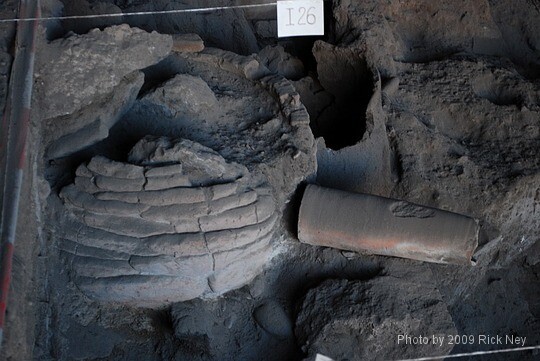The cave Areni — cave complex located near the village of Areni in the Vayots Dzor region in southern Armenia. In the cave, located at an altitude of about 1080 m above sea level, the researchers have discovered several cultural layers, including the complex era of the copper-stone age (Eneolithic) with Adobe buildings Dating back to 4200-3500 years BC. The oldest cultural layer belongs to the VI—V thousand years. BC, and the later to the XII—XIV centuries.
The arrangement and structure of the caves
The cave of Areni is famous also under the name of birds ‘ cave located in the South-East of Armenia, Vayots Dzor region, at 12 km from the town of Yeghegnadzor. Emerged consisting of three halls cave in the limestone rock formations of the valley of the ARPA river.
The cave entrance is a narrow cleft in the rocky limestone formations of the left Bank of ARPA river. In front of cave rock which closes the horizon. Ascent to the cave from the highway on a steep slope is 30-35 m. the Area of the cave is according to various data, from 400 to more than 600 square meters, moving away from her in side, several compartments or galleries.
Inside the monument top hanging covered with black masses of the arches. The cave has many corridors and passages, which were partially inherent in ancient times.
History
In ancient times the cave was a significant settlement Gavar Gegharkunik Syunik Ashkharh of great Armenia. The fifth century historian Yeghishe Areni was mentioned under the name Arpana, Aponal, (Arsenal). The settlement was a military road point and the node spanning the gorge, which connected the plain with the Sharur region of Vayots Dzor. It had trade relations with different territories across the Middle East, evidence of this is found in the cave ceramics of the four types, and only one of them is considered to be utensils of local production.Nearby from the cave hills (gorge of Amaghu) in ancient times was a fortress and castle, the ruins of which have survived to the present day.
The cave was discovered by the scientific employee of Institute of archeology and Ethnography of NAS RA, archaeologist Boris Gasparyan, it was a lot of bird nests and through the cave entrenched the alternative name of the Bird. Nearby is a restaurant that is by the cave decided to expand in arranging her new room. However, shortly after the beginning of the the restaurant owner died.Locals say that the spirits of the cave, arranged for the extension of the explosions did not like and they took away the soul of a careless Builder with him into the mountain.Since 2007, the cave is explored more archaeological than 12 institutions from 9 countries.
Excavations
Archaeological work in the cave has been conducted since 2007, an expedition led by Boris Gasparyan (Armenia), Gregory Areshian (USA) and Ron Pinhasi (Ireland). In the excavations involved scientists from the Institute of archaeology and Ethnography Armenian Academy of Sciences, the California Institute named Lloyd Cotsen, Cork University College, Ireland, University of Connecticut (UConn, USA) and the universities of Haifa and tel Aviv (Israel).
A preliminary reconnaissance was possible to establish that the cave has at least 5-6 layers of Eneolithic era, with a depth of over four meters (radiocarbon dates ranging 4300-3500 BC). At the entrance to the cave on the area of 85 m2 in the excavation discovered the remains of dwellings, paved courtyard and mudbrick structures. In the back of the cave in the area of 40 m2 open storage area with dug into the deposits of vessels for storage of food reserves and the circular earthen structures of industrial purpose.
Pottery discovered by archaeologists are similar to the dishes of the first phase of the Kura-Araxes culture similar to the artifacts found during excavations of other monuments of Armenia as Talin and ELAR. Techno-typological differences of the pottery of these two different chronological relationship of the layers suggests the possibility of two early (4000-3700 BC) and late (3600-3500 BC) phases in the late Chalcolithic southern Caucasus.Finding ceramics for technical and tekhnologicheskim features repeating Neolithic ware, and the forms close to the samples of pottery of the Kura-Araxes culture in excavated layers (in the first horizon, the number of such samples increases), tells about the origin of the pottery of the Kura-Araxes culture of the Eneolithic.
Finds made in the cave, suggest the origin of civilization on the territory of modern Armenia, 800 years earlier than previously thought, approximately at the same time as in South of Iran. Thanks to these excavations were able to establish that the Maikop culture and the culture of the Kura-Araks appeared and spread to 1,000 years earlier than previously thought in academic circles.
Interesting facts
- After numerous publications in mass media about the findings and the course of excavations at the famous cave was hit by an unprecedented popularity, which nearly cost the «life» of the objects of ancient daily life. The archaeological expedition was very disturbed tourists who, without permission, entered the cave, not even thinking that something may break. As a result it was decided to close the entrance to the cave after the excavation is completed.
- About the excavations in the cave of Areni, archaeologists from different countries talking during scientific conferences for many years. Information on the excavations is published in the form of articles or interviews in magazines and Newspapers, but the world’s attention to the cave increased after June 9, 2010, the us National Geographic channel has prepared a special report dedicated to its unique historical treasure.
.










